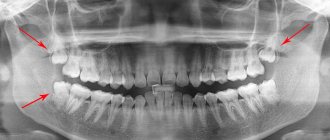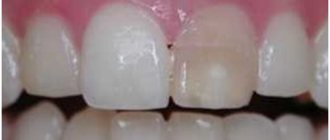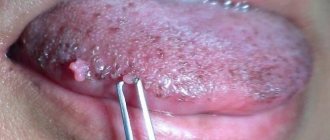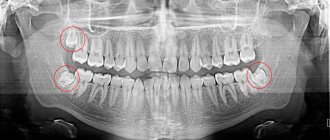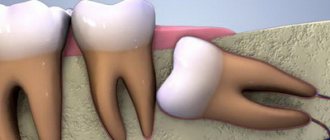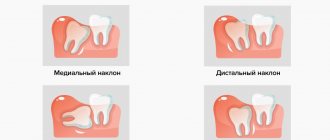In dentistry, eights firmly hold the status of the most problematic teeth. The list of adverse consequences that their owners have to face is very extensive.
Possible complications
Often third molars grow unevenly, damaging the tissues of the oral cavity. Improper growth is accompanied by pain, aggravated by chewing, and bleeding gums. Pain may also occur, radiating to the jaw, ear, and temple. If you experience such symptoms, do not hesitate to visit your dentist.
After the examination, he will decide whether to remove the discomforting figure eight. To the question: “How long does it take to remove a wisdom tooth?” It is impossible to answer unambiguously. In simple cases, the manipulation takes 20 minutes, in difficult cases – from one to two hours. Its duration depends on the surgical strategy, which is determined individually depending on the clinical picture.
Indications for wisdom tooth removal
1. Dental dystopia.
The highest percentage of complications is caused by atypically growing wisdom teeth. Dystopia manifests itself as a deviation from the normal position. A common cause of dystopic third molars is lack of sufficient space. Eights are massive and require a lot of space for proper placement, and modern humans have relatively compact jaws.
As a result of the uneven growth of eights, the following negative situations arise:
- Chronic cheek injury (erosions, ulcers, hyperkeratosis).
- Hidden caries.
- Formation of periodontal pockets.
- Disorders of the mandibular joint.
2. Tooth retention.
When unerupted third molars exist under the gum, they are called impacted. If they erupt partially, they are semi-retinated. With complete retention, the figure eight may not bother its owner, and it is accidentally detected on an x-ray.
Partial retention is fraught with unpleasant consequences, including:
- Inflammation of the gingival hood;
- Periostitis (flux);
- Tooth cyst;
- Hidden caries.
Third molars can exert pressure on neighboring teeth, which is transmitted along the “chain” along the entire row. Sometimes even the incisors become deformed due to their fault. The growth of impacted eights displaces teeth after orthodontic correction. Therefore, before treatment with an orthodontist, it is advisable to get rid of them.
Other reasons.
- Normally erupted third molars are removed for the same reasons as the remaining teeth:
- Presence of perihilar cysts;
- Volumetric destruction of the crown or root system that is not subject to therapeutic treatment;
- Mobility 2-3 degrees;
- Injury.
Wisdom tooth – “secret agent”
Few people know in detail what kind of tooth this is and what its “wisdom” is.
And everything is quite simple - he is called that because he/they appear much later than the others, at the age when a person’s mental development is considered complete, and the acquisition of wisdom begins. It does not have a “milk” predecessor, and it grows only after the final formation of adult bone tissue. In our time, it has been proven: the wisdom tooth, also known as the eighth tooth, is a rudiment, a relic of evolution. Unlike ancient humans, our jaw is shorter, and there is simply no room for it. That's why Western dentists insist: it must be removed as soon as it begins to appear. However, in any case, if the “eight” causes pain, your best assistant is the dentist! After looking at the x-ray, he will tell you what to do next. If everything is fine with the newly erupted tooth, the dentist will prescribe a course of treatment that will relieve inflammation.
what to do with the eighth teeth based on the patient’s complaints and clinical picture. Problems with even one or two elements disrupt the normal functioning of the entire dental system. Pain appears when opening the mouth and chewing, sometimes the bite and position of the incisors change.
So, if the eighth tooth is problematic, then the surgeon will perform an operation to remove it.
Wisdom teeth that have not erupted or are in the wrong position make removal more difficult and require the use of a complex extraction method.
We remove the nerve, save the tooth
Removal of the nerve - depulpation - is necessary when:
- As a result of injury, the tooth enamel is chipped so badly that the nerve is affected.
- pulpitis was detected. Inflammation of the nerve can begin as a result of advanced caries.
- you are preparing for prosthetics and installation of orthopedic structures.
Removing a nerve today no longer requires the use of arsenic, and modern anesthesia literally works miracles. Not only the capital, but also Samara can boast of modern clinics where you can get rid of the nerve without hassle and pain. How much does it cost? The prices are quite reasonable!
Yes, after removing the nerve, the tooth will lose sensitivity and blood supply. But when the nerve disappears, the painful reaction to all irritants, including sweets, cold and hot, will also go away.
In any case, the dentist advises removing the nerve only when it is no longer possible.
How is wisdom tooth extraction performed?
Based on the figure eight state, the dental surgeon chooses a simple or complex surgical intervention algorithm.
Easy removal
It is used in case of a typical location of a wisdom tooth, if its coronal part is sufficiently preserved. For example, the 8th teeth can be removed in this way in case of periodontitis, when damage to the cement leads to their loosening. The duration of the operation is influenced by the structural features and branching of the roots. If there are no difficulties, the procedure takes about 20 minutes.
Sequencing:
- Anamnesis collection. At this stage, a survey is conducted to identify common diseases and contraindications.
- X-ray diagnostics. From the image, the doctor assesses the orientation and condition of the root system.
- Local anesthesia. The type of anesthetic injections for removal is selected taking into account allergic reactions and personal intolerance.
- Using special instruments, the gums are peeled off to prevent soft tissue injury.
- The surgeon rocks the tooth while holding it with forceps. This destroys the ligaments that firmly hold it in the bone.
- Direct tooth extraction.
- If there are bone fragments left in the hole, they are carefully removed.
- After treatment with antiseptics, an anti-inflammatory medicine is placed in the hole.
- If during the operation a large cavity with damaged edges is formed, the wound is sutured.
Difficult removal
When it is not possible to extract a tooth with forceps, you have to resort to a special surgical technique. Candidates for complex removal are impacted and dystopic wisdom teeth. In such situations, they are accessed through an incision in the gum.
Such manipulation causes unreasonable fear in patients, but there is no need to be afraid of it. It is performed quickly and absolutely painlessly. Problem eights that are not removed in time cause much more trouble.
Stages of complex tooth extraction:
- Anesthesia.
- Gum cutting. If the tooth is “hidden” deeply, the mucoperiosteal flap is peeled off.
- A hole is drilled in the jawbone using an ultrasonic instrument or bur.
- The tooth is extracted.
- If the figure eight is large in size, it is divided into parts and each fragment is extracted separately.
- An analgesic and regeneration-accelerating drug is placed into the cavity.
- Stitches are applied.
When the likelihood of successful treatment is low and the doctor may suggest tooth extraction
Examples of a less favorable situation:
1) The crown of the tooth is severely damaged. All that was left of the tooth was the root. This means that the tooth will have to be restored with a crown on the stump tab.
tooth restoration with a core inlay and crown
You will find more detailed information in the article What guides a dentist when he suggests restoring a tooth: with a filling, inlay, veneer or crown?
2) The x-ray shows significant destruction of bone tissue. This means that bone restoration will take longer and worse.
3) Root canals have a complex shape and removing all the infected pulp (“dental nerve”) from them is a difficult task.
4) The roots of the tooth are thin and curved. Expansion of the canals when removing infection from them can lead to the fact that the walls of the tooth cannot withstand the chewing load.
There are many difficulties in endodontic treatment; it is not for nothing that this area of dentistry is considered one of the most difficult. In the article Why you can’t give a 100% guarantee on tooth root canal treatment, we talk in detail about the difficulties of endodontic treatment, but here we will only demonstrate what a bizarre shape canals can be.
shape of the canals of the teeth of the upper and lower jaw
5) The tooth canals were previously filled. Canal retreatment is the “highest aerobatics” in endodontic treatment. It is not always possible to even unseal them. Sometimes this treatment leads to tooth extraction.
6) After unsuccessful endodontic treatment, a pin or a fragment of an instrument is fixed in the root canal. Removing foreign bodies from canals is a complex procedure with an unknown result.
7) Several teeth are missing in the oral cavity and an increased load is placed on the diseased tooth. Any depulped (“dead”) tooth copes with its function worse, since after removal of the “nerve” it becomes more fragile.
 The presence of granuloma and cyst further weakens the tooth.
The presence of granuloma and cyst further weakens the tooth.
9) The tooth periodically worries and the patient is “tired” of it.
10) The patient has concomitant diseases. And since any chronic disease weakens the immune system, the likelihood of successful treatment decreases.
The indication for tooth extraction may be one or more of the listed reasons.
How does the healing of an extracted tooth proceed?
Knowing what your gums should look like after wisdom tooth removal will help you track negative symptoms and consult a doctor in time to eliminate them. After 15-30 minutes, a blood clot with a bright burgundy color forms in the hole. It protects internal tissues from infection and promotes successful healing.
If there is no clot, they speak of “dry socket” syndrome - an undesirable complication that leads to suppuration of the wound. In this situation, the dentist will clean the hole and fill it with anti-inflammatory gel to avoid unpleasant consequences.
On the 3-4th day, the wound begins to become covered with a white film. Over the course of 2 weeks, the hole is covered with new epithelium and is visually indistinguishable from healthy gums. Bone structures are completely restored in 4-6 months.
Painless tooth extraction.
For painless tooth extraction, local anesthesia . Therefore, there is no need to worry about pain associated with this procedure. In this case, the main thing is to follow several rules of the postoperative period in order to minimize discomfort and pain:
- After tooth extraction, do not drink hot foods
- do not mechanically impact the removal site (tongue, food, toothbrush)
- do not rinse, do not drink alcohol, minimize physical activity
Depending on the specific situation and the task at hand, one of the methods of tooth extraction is used:
- traditional removal (mechanical removal)
- atraumatic removal (using ultrasound)
In some cases, tooth extraction involves serious surgical intervention, when not one of the above-mentioned options in its pure form is impossible due to one reason or another. Before removing a tooth, experts recommend taking an X-ray or tomography.
Kodak Carestream CS9300
What is the difference between removing top and bottom eights?
Removing a tooth in the lower jaw is more difficult. The reason lies in the greater density of the alveolar process and the branching of the roots. When removing lower third molars, the risk of breaking off a root fragment increases, so the operation has certain specifics. To completely eliminate pain, conduction anesthesia is used here. In this case, the nerve through which the pain signal is transmitted is blocked for a long time. In the upper jaw, infiltration anesthesia, the so-called “freezing,” copes with the task of effective pain relief.
Tooth extraction: painful or not?
The popular idea of discomfort during the removal of a “wise” tooth is nothing more than a myth. Even the most complex dental operations are performed without the slightest pain, and painless removal of the third molar has long become the standard of an ordinary clinic.
The latest generation carpule anesthetics leave no chance for pain. The needle of a carpule syringe is thinner, so its insertion into the tissues of the oral cavity is almost not felt. To relieve sensitivity of the gums at the injection site, it is first lubricated with an anesthetic gel.
Particularly susceptible people experience psychological discomfort from the sounds of rocking a tooth with forceps. To eliminate stress, dentists use sedatives. Extraction with sedation allows the patient to relax in the dentist's chair and relieves anxiety.
Treat tooth?
Naturally, treating a neglected tooth that hurts for days costs an order of magnitude more than removing it and may require several visits to the doctor. But compared to implantation and prosthetics, which follow after removal, treatment is still much cheaper.
True, there are cases with absolute indications for removal: such as tooth destruction at the root level, when after removing all damaged tissue, it cannot be restored either with a filling, or an inlay, or a crown.
Therefore, it is right for everyone to undergo regular examinations by the dentist and not lead to deep tooth decay.
Get regular dental checkups and treat caries in the early stages, then you won’t have to make a choice between tooth extraction and complex treatment.
